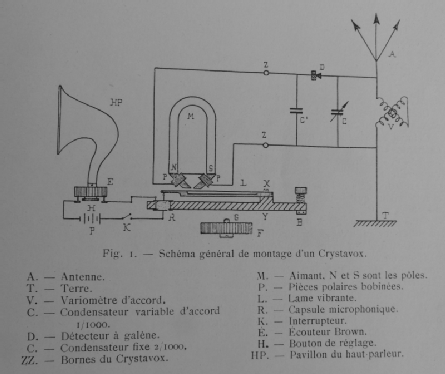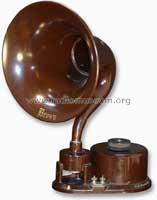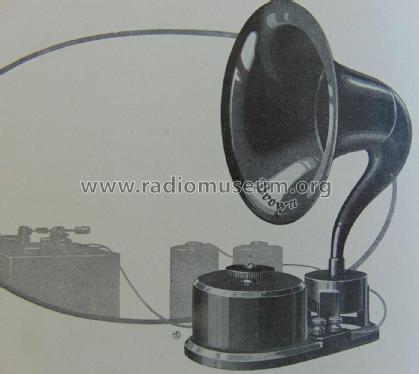Crystavox amplifying speaker
Brown S. G. Ltd.; London
- País
- Gran Bretaña (GB)
- Fabricante / Marca
- Brown S. G. Ltd.; London
- Año
- 1923
- Categoría
- Altavoz, cascos o auricular
- Radiomuseum.org ID
- 104231
Haga clic en la miniatura esquemática para solicitarlo como documento gratuito.
- Principio principal
- Amplificador de Audio
- Gama de ondas
- - no hay
- Especialidades
- Loudspeaker + integr.Amplifier
- Tensión de funcionamiento
- Baterías recargables o pilas / 6 Volt
- Altavoz
- Corneta / Ø 13 inch = 33 cm
- Material
- Materiales diversos
- de Radiomuseum.org
- Modelo: Crystavox amplifying speaker - Brown S. G. Ltd.; London
- Forma
- Formas varias descritas en notas aparte.
- Ancho, altura, profundidad
- 13 x 0 x 0 inch / 330 x 0 x 0 mm
- Anotaciones
- Combined horn loud-speaker and Microphone amplifier (mechanical, valveless) for crystal set use. Brown-enamelled cast metal neck, spun flare.
- Precio durante el primer año
- 6.00 £
- Mencionado en
- Radio! Radio! (fig.827)
- Documentación / Esquemas (1)
- Le Guide du Collectionneur TSF Biraud/Foster, Vol. II (page 417)
- Otros modelos
-
Donde encontrará 54 modelos, 44 con imágenes y 3 con esquemas.
Ir al listado general de Brown S. G. Ltd.; London
Contribuciones en el Foro acerca de este modelo: Brown S. G. Ltd.;: Crystavox amplifying speaker
Hilos: 1 | Mensajes: 1
At first the bigger telephone companies with long distance facilities had to use human repeaters to repeat each word of the telegraph messages or even conversation (or parts of the conversation in better cases). This was not only costly, unprivate and slowing down the conversation - but also errors could occur.
An electro-mechanical repeater was a replacement for a human repeater. A human telegrapher could write down the received message and then he or another telegrapher could repeat it by sending via the next link in the path from origin to destination.
From this historical beginning, we use the name “repeater” for any device that “regenerates” a stronger signal, retimes and reshapes the signal waveform; the classic functions of a repeater.
S. G. Brown, England, invents such a repeater as a telephone repeater also called Telephone Relay in 1908-1914. In 1914 it works for instance in Leeds for the line London-Glasgow. It was even a half duplex system. Siemens bought some rights (1910) to improve and build it's own mechanical repeaters. We believe that Robert Denk used such a device for his hoax of a tubeless radio with loudspeaker in 1948 instead of a then new transistor or transitrone.
S.G. Brown Ltd. London even built a loudspeaker Crystavox (click above the model) with amplification (1923) for use with cristal detectors. They were also marketed in other countries (like Austria). His microphone amplifiers with this electro-mechanical principle were available from 1925. His repeaters for underwater cables was famous. It is said (in Vienna "Wiener Herbstmesse 1924") that the device had an effect like an early audio amplifier with two tubes.
The Crystavox uses two magnetic coils on a horseshoe magnet (2000 Ohm). A metal piece touches with its tip a carbon microphone which feeds an audio transformer with a battery of 6 volts in series. The secondary feeds a loudspeaker. Brown was famous for loudspeakers - not only in England or Great Britain.
Historical note:
"Most counties in the state of Texas are approximately square, 30 miles on each side. This was done to make a 30 mile (50 km) telegraph link feasible from the center of one county to another in an adjacent county, without a repeater. Texas also required every county to build its county court house within 3 miles of the county center point.
In the mid 19th century many telegraph companies merged into the Western Union Corp., the first nationwide business and the first telecom monopoly.WU played an important role in the development of the telephone by not buying the patent when first offered. WU was bought and then sold by AT&T in the early 20th century. WU discontinued telegram service in 2006 and now is primarily in the money transfer business."
Ernst Erb, 30.Jan.08



